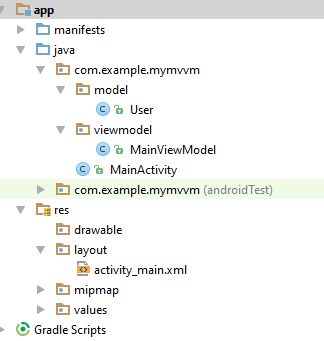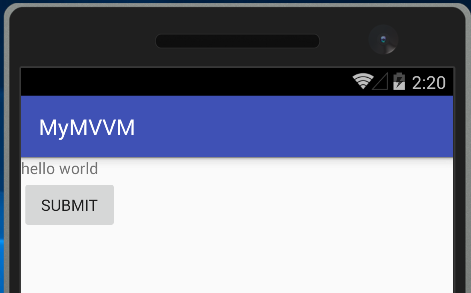android mvvm初探
目前google的databinding library还处在rc版,其中编译器发挥了主要作用。目前也只是在android studio开发环境中支持。
mvvm能够大大降低模块间的耦合度,在开发过程中更容易控制数据传递,性能方面也有所长,传统findViewById要遍历整个树的children。
它的编译过程:
1. 首先会去检查layout下的视图文件,将其中所有关于databinding的元素全部删除、替换(这一过程全部由编译器来完成,可以搜索下build文件夹视图文件),因为这些标签根本无法识别。
2. 第二步解析表达式语法,如三目运算。
3. 第三步解析绑定值,对应java code中的含义。
4. 第四步会生产databinding class文件,这些文件由编译器自动生成。
由于它是预编译的,没有了运行时的反射提高了性能,但并不能真正体现view层和behind层的分离,当我们在view层指定了一个java code中不存在的属性,这时候编译将不会通过。
新建project

引入类库
通过android sdk manager下载android support respository。build.gradle(Moudle:app)加入定义:
android {
....
dataBinding {
enabled = true
}
}
添加viewmodel
这里提供视图数据,相当于shh中service层吧,主要放置属性、集合和事件方法。
1 package com.example.mymvvm.viewmodel; 2 3 import android.databinding.BaseObservable; 4 5 import com.example.mymvvm.model.*; 6 7 public class MainViewModel extends BaseObservable { 8 9 public MainViewModel() { 10 this.Init(); 11 } 12 13 // attribute 14 private User user; 15 16 public User getUser() { 17 return user; 18 } 19 20 public void setUser(User user) { 21 this.user = user; 22 } 23 24 // method 25 public void Init() { 26 this.user = new User(); 27 this.user.setName("who are u"); 28 } 29 30 // command 31 public void SubmitCommand(android.view.View view) { 32 this.user.setName("hello world"); 33 } 34 }
user类
@Bindable注解,编译时会在BR中生产BR.name,BR作用就是相当于一个观察者,而不会去监视整个project资源。
添加notifyPropertyChanged,当name值改变,能够及时通知到UI界面。
1 package com.example.mymvvm.model; 2 3 import android.databinding.BaseObservable; 4 import android.databinding.Bindable; 5 6 public class User extends BaseObservable { 7 8 @Bindable 9 private String name; 10 11 public void setName(String name) { 12 this.name = name; 13 notifyPropertyChanged(com.example.mymvvm.BR.name); 14 } 15 16 public String getName() { 17 return name; 18 } 19 }
注册viewmodel
这里建立和view试图对应关系,编译时会自动检测binding元素。
ActivityMainBinding会自动根据active_main.xml视图生产,注意名称对应。
1 package com.example.mymvvm; 2 3 import android.databinding.DataBindingUtil; 4 import android.support.v7.app.AppCompatActivity; 5 import android.os.Bundle; 6 7 import com.example.mymvvm.viewmodel.*; 8 import com.example.mymvvm.databinding.ActivityMainBinding; 9 10 public class MainActivity extends AppCompatActivity { 11 12 @Override 13 protected void onCreate(Bundle savedInstanceState) { 14 super.onCreate(savedInstanceState); 15 ActivityMainBinding binding = DataBindingUtil.setContentView(this, R.layout.activity_main); 16 binding.setMainViewModel(new MainViewModel()); 17 } 18 }
添加view
1 <?xml version="1.0" encoding="utf-8"?> 2 <layout xmlns:android="http://schemas.android.com/apk/res/android"> 3 <data> 4 <variable name="mainViewModel" type="com.example.mymvvm.viewmodel.MainViewModel" /> 5 </data> 6 7 <LinearLayout android:orientation="vertical" 8 android:layout_width="match_parent" 9 android:layout_height="match_parent"> 10 <TextView android:layout_width="wrap_content" 11 android:layout_height="wrap_content" 12 android:text="@{mainViewModel.User.name}" /> 13 <Button android:layout_width="wrap_content" 14 android:layout_height="wrap_content" 15 android:text="submit" 16 android:onClick="@{mainViewModel.SubmitCommand}"/> 17 </LinearLayout> 18 </layout>
结果
当点击submit按钮,触发command事件。

android studio编译器最大程度降低了代码的复杂性,编译器做了很多幕后工作,可以看下build后的文件。
得益于INotifyPropertyChanged,INotifyPropertyChanging接口,微软反而在mvvm这块显得更加简洁有力。


 浙公网安备 33010602011771号
浙公网安备 33010602011771号